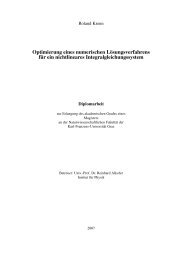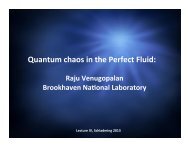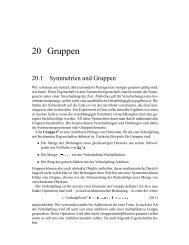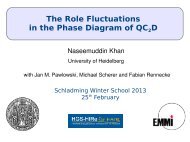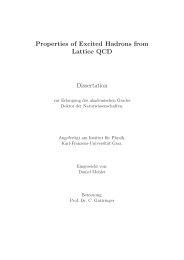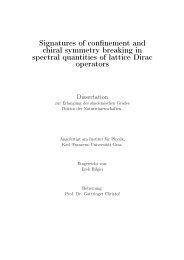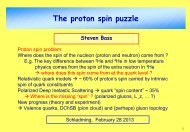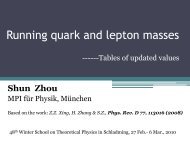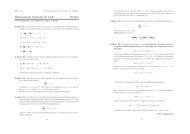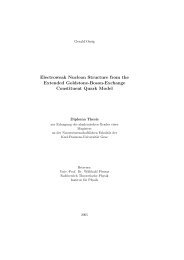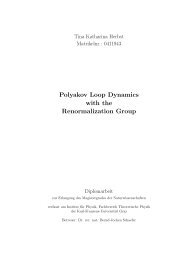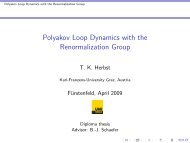The QCD Quark Propagator in Coulomb Gauge and - Institut für Physik
The QCD Quark Propagator in Coulomb Gauge and - Institut für Physik
The QCD Quark Propagator in Coulomb Gauge and - Institut für Physik
Create successful ePaper yourself
Turn your PDF publications into a flip-book with our unique Google optimized e-Paper software.
60 6.3. Covariant Faddeev equation<br />
where: the sp<strong>in</strong>or satisfies<br />
(iγ · P + M) u(P) = 0 = ū(P) (iγ · P + M) , (6.10)<br />
with M the mass obta<strong>in</strong>ed by solv<strong>in</strong>g the Faddeev equation, <strong>and</strong> it is also a sp<strong>in</strong>or <strong>in</strong><br />
isosp<strong>in</strong> space with ϕ + = col(1, 0) for the proton <strong>and</strong> ϕ − = col(0, 1) for the neutron. <strong>The</strong><br />
momenta are given as K = p 1 + p 2 =: p {12} , p [12] = p 1 − p 2 , l := (−p {12} + 2p 3 )/3. ∆ 0+<br />
is a pseudoparticle propagator for the scalar diquark formed from quarks 1 <strong>and</strong> 2, <strong>and</strong><br />
Γ 0+ is a Bethe-Salpeter-like amplitude describ<strong>in</strong>g their relative momentum correlation.<br />
And S, a 4 × 4 Dirac matrix, describes the relative quark-diquark momentum correlation.<br />
<strong>The</strong>se objects are discussed <strong>in</strong> more detail <strong>in</strong> secion 6.3.2. <strong>The</strong> colour antisymmetry of<br />
Ψ 3 is implicit <strong>in</strong> Γ JP , with the Levi-Civita tensor, ǫ c1 c 2 c 3<br />
, expressed via the antisymmetric<br />
Gell-Mann matrices. Explicitly we def<strong>in</strong>e<br />
{H 1 = iλ 7 , H 2 = −iλ 5 , H 3 = iλ 2 } , (6.11)<br />
<strong>and</strong> then we have ǫ c1 c 2 c 3<br />
= (H c 3<br />
) c1 c 2<br />
. (See equations(6.43), (6.44).)<br />
<strong>The</strong> axial-vector component <strong>in</strong> equation(6.7) is<br />
N 1+ (p i , α i , τ i ) = [t i Γ 1+<br />
µ (1 2 p [12]; K)] τ 1τ 2<br />
α 1 α 2<br />
∆ 1+<br />
µν (K) [Ai ν (l; P)u(P)]τ 3<br />
α 3<br />
, (6.12)<br />
where the symmetric isosp<strong>in</strong>-triplet matrices are<br />
t + = 1 √<br />
2<br />
(τ 0 + τ 3 ) , t 0 = τ 1 , t − = 1 √<br />
2<br />
(τ 0 − τ 3 ) , (6.13)<br />
with (τ 0 ) ij = δ ij <strong>and</strong> τ 1,3 the usual Pauli matrices, <strong>and</strong> the other elements <strong>in</strong> equation(6.12)<br />
are straightforward generalisations of those <strong>in</strong> equation(6.9).<br />
<strong>The</strong> general form of the Faddeev amplitude for the sp<strong>in</strong>- <strong>and</strong> isosp<strong>in</strong>-3/2 ∆ is complicated.<br />
However, isosp<strong>in</strong> symmetry means one can focus on the ∆ ++ with it’s simple<br />
flavour structure, because all the charge states are degenerate, <strong>and</strong> consider<br />
D 1+<br />
3 = [t + Γ 1+<br />
µ (1 2 p [12]; K)] τ 1τ 2<br />
α 1 α 2<br />
∆ 1+<br />
µν (K) [D νρ(l; P)u ρ (P) ϕ + ] τ 3<br />
α 3<br />
, (6.14)<br />
where u ρ (P) is a Rarita-Schw<strong>in</strong>ger sp<strong>in</strong>or, equation(A.12).<br />
<strong>The</strong> general forms of the matrices S(l; P), A i ν (l; P) <strong>and</strong> D νρ(l; P), which describe the<br />
momentum space correlation between the quark <strong>and</strong> diquark <strong>in</strong> the nucleon <strong>and</strong> the ∆,<br />
respectively, are described <strong>in</strong> reference[OHAR98]. <strong>The</strong> requirement that S(l; P) represent<br />
a positive energy nucleon; namely, that it be an eigenfunction of Λ + (P), equation(A.9),<br />
entails<br />
S(l; P) = s 1 (l; P) I D +<br />
(iγ · ˆl − ˆl · ˆP<br />
)<br />
I D s 2 (l; P) , (6.15)



